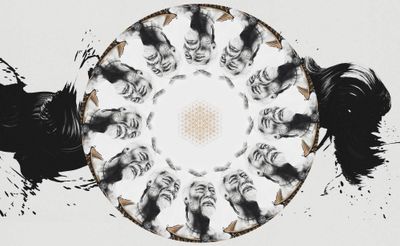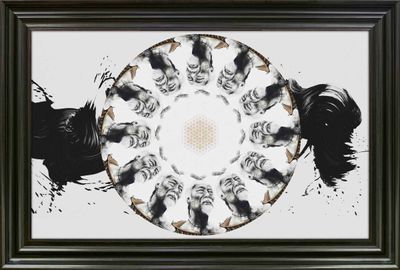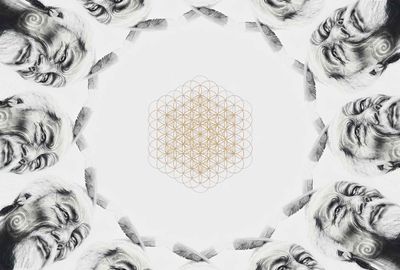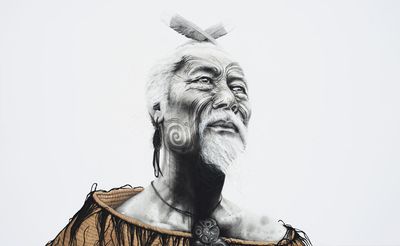




Twelve Heavens
$3,750.00
Original painting AVAILABLE, digital design & painted flashe on canvas, 1230 x 1820mm, 2018. Contact us to enquire about the original.
Explore the story of the artwork >>
Print sizes and editions
- Regular museum archival paper print - 500 x 809mm
(limited to 275) - Large museum archival paper print - 712 x 1152mm
(limited to 275) - Extra Large museum canvas print - 820 x 1315mm
(limited to 275)
Your unique limited edition fine art print
- Sofia Minson creates your exclusive signed print
- We ship for $25 in NZ and from $50 internationally
- Your artwork arrives rolled, ready to be framed - do you need help? Request framing guidance
The story of Twelve Heavens
Twelve Heavens is a cosmic portrait of the twelve celestial realms of Rangi. From the summit of the heavens, Tikitiki-o-rangi, to the realm closest to earth, Rangi-nui (Sky Father).
Cosmic lineage
First is Te Kore, the formless void. Unlimited potential for being. From that womb of emptiness comes Te Pō, the night that lasts for aeons. A slow dawning conception of light seeds itself in the prevailing darkness. Moisture emerges and couples with a cloud that grew from the dawn. From this union comes the Twelve Heavens of Rangi. Ranginui, the sky above is nearest to Papatūānuku, his lover the earth.
Symbol of the void
The splattering black paint stroke represents Te Kore. It symbolises creative work or the making of something novel, whether it be material or conceptual. The process is sometimes messy, curvy and uncontained. It is yin (feminine) in nature. It is the receptive flow state, from which we receive divine inspiration.
Twelve-sided Mandala
The wheel of repeating faces forms a twelve-sided mandala. In Hinduism and Buddhism, mandalas are sacred geometric symbols that represent the cosmos and are used to aid meditation.
Placing Rangi inside a circle indicates that growth in the direction of enlightenment is cyclical. There is a spiralling path of many lessons upward, there is never a straight line. The goal is to evolve through cycles toward autonomy and away from our subconscious programming.
Sacred geometries lie at the heart of the mandala. You can see the intersecting circles of the Flower of Life. It is a mathematical symbol found in most ancient cultures, including 'laser-burned' into granite at The Temple of Osiris in Egypt. Also present are the Fruit of Life, The Star of David and the Merkabah. These 2D shapes are representations of living energy fields that surround the human body.
Portrait of Ranginui
The portrait of Rangi was inspired by dozens of black and white 19th-century photographs of Māori. Portraits by C.F. Goldie and Gottfried Lindauer were also influential.
Rangi has the indelible mark of Tā Moko Kanohi (face tattoo) encoding his whakapapa. He wears a woven korowai (cloak) painted in metallic gold. His heitiki pendant and earrings are signs of mana and status.
Two white-tipped huia feathers cross each other at the crown of his head. In myth, the huia was once a pure white bird. He was taken from the head of an atua (god) who dwelt in the highest of the twelve heavens. The humble bird was sent on a journey down through the twelve realms of Rangi to earth. His task was to relay a message to Tāne, god of all living things and progenitor of mankind. The message was that it was time for Tāne to climb the heavens to retrieve the sacred baskets of knowledge.
As a gift for transmitting this important message, the atua transformed the white bird's body to black. This represented Te Kore and his journey through the twelve dimensions. More feathers were added to his tail to make twelve in total and the tips were left white to mark the heavens. Lastly he received a new name - Manu Huia.
Multimedia
The technique Sofia used here fuses digital and analogue.
"It repurposes a pre-existing symbol in my work, the portrait of Rangi, and places him in a fresh context. I hand-painted Rangi at a large scale using watery washes of flashe (vinyl paint) on canvas. I took a high-resolution digital capture of the painted work. Using digital technology I created this repeating twelve-sided mandala pattern. Having printed this on canvas, I created the rest of the composition by hand using acrylic and flashe paints. The portrait in this new context, takes on a more complex meaning." - SOFIA MINSON
Sofia Minson Paintings | New Zealand Artwork



